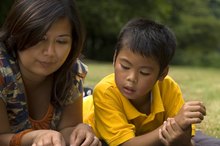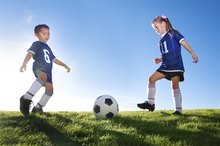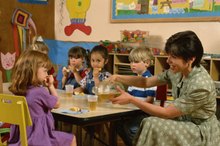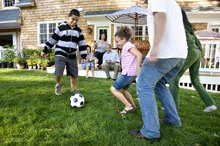Environmental, Cultural and Social Factors That Influence Motor-Skill Development in Children
Many factors impact the rates at which children develop motor skills -- environmental, cultural and social factors all play a role 1. While there are genetic aspects to consider when evaluating gross and fine motor skills, most researchers agree that non-genetic factors have an equal effect.
Environmental Factors
A child's living conditions, level of parental involvement and educational experiences all affect his motor-skill development. According to a 2009 article for the "Early Childhood Education Journal" titled "Environmental Factors Affecting Preschoolers' Motor Development," parents and caregivers influence the level at which a child develops his motor skills. The article explains that higher socioeconomic status and intellect positively correlate with more advanced motor-skill development. Parents and caregivers who provide consistent opportunities for active play encourage the growth of motor skills in a child's environments at home and at school.
- A child's living conditions, level of parental involvement and educational experiences all affect his motor-skill development.
- According to a 2009 article for the "Early Childhood Education Journal" titled "Environmental Factors Affecting Preschoolers' Motor Development," parents and caregivers influence the level at which a child develops his motor skills.
Cultural Factors
Visual Perception Problems in Children
Learn More
A child's culture directly influences the rate and level of motor-skill development. Typical American children roll over at 3 months, sit at 6 months and walk at 12 months. However, in other cultures around the world, the time frame for development can differ. Natural observations of world cultures show that climate, housing and culturally based child-rearing practices strongly impact the development of motor skills.
- A child's culture directly influences the rate and level of motor-skill development.
Social Factors
Personality, self-perception and self-motivation are examples of social indicators that impact motor-skill development 1. Albert Bandura, whose social learning theory focuses on how children learn in all areas of development, suggests that children who believe they can acquire new skills are more likely to try harder when challenged, less likely to become discouraged and more likely to positively react to learning experiences. However, children who view their abilities as a reflection of their aptitude tend to have a negative reaction when they have trouble mastering a skill.
Intervention for At-Risk Children
Can Moving Often Affect a Child's Development?
Learn More
Communities and schools often provide free programs aimed at assisting at-risk children and their families. Intervention programs and activities can counteract negative environmental, cultural and social factors. Identifying at-risk children, educating parents and working with families in and out of the home can help to bridge the gap that develops from deficits in these areas, helping children who fall behind in motor development to catch up. Parents and caregivers can locate these services and programs by contacting local community service boards or by asking school administrators.
- Communities and schools often provide free programs aimed at assisting at-risk children and their families.
- Parents and caregivers can locate these services and programs by contacting local community service boards or by asking school administrators.
Related Articles
References
Writer Bio
Sharon Bolling holds a master's in counseling and human development with a concentration in school counseling from Radford University. She is an experienced instructor of both high school and college students. She has been writing for Demand Media online since April 2013.








